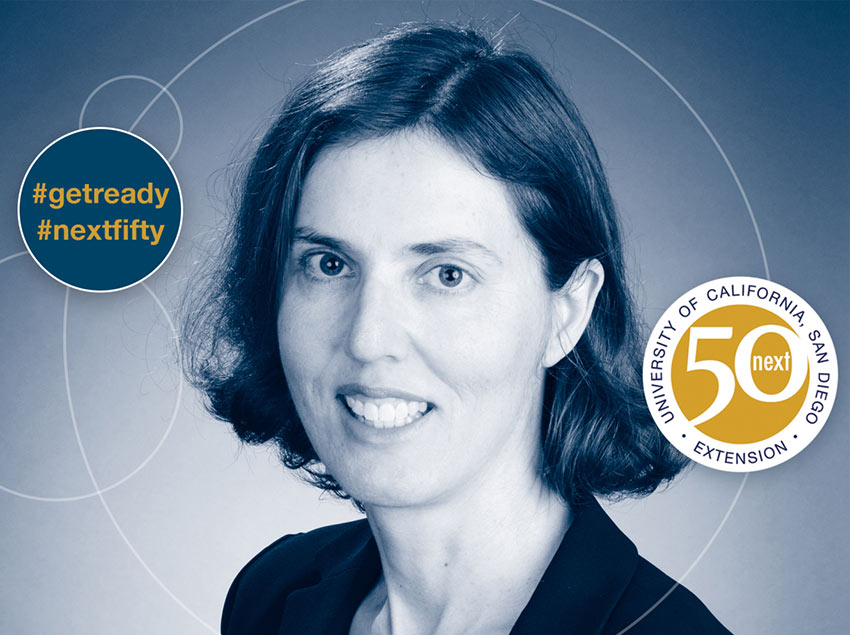By Alex Roth

In honor of UC San Diego Extension’s first 50 years, 50 Voices of the Future asks thought leaders about the trends, breakthroughs and social advances they foresee over the next 50 years.
Trying to reduce the spread of disease is an endeavor that can make a scientist pessimistic. There is always some new illness waiting to unleash itself on humanity. Dr. Kimberly Brouwer, a professor in the Epidemiology division of UC San Diego Family Medicine and Public Health and adjunct at UC San Diego Global Health, believes disease will remain a global problem for the foreseeable future. What’s encouraging, she says, is our ability to respond to these new threats far more rapidly than in the past. “With better surveillance and communications we can catch things much earlier than ever before,” she says. Decades from now, she predicts, we will be even more adept at mobilizing against whatever new diseases might pose the latest threat.
(1) Why is the work you do important?
There are always emerging infections we’re looking for. We’re looking for a better understanding of what causes disease and its transmission. Even for diseases that are well-known, epidemiology is very useful in that it can help you understand why certain people are more at-risk than others, why certain people are having a harder time accessing care or working under a certain treatment regimen than others. So it’s a very useful way to make informed decisions and provide the data that policy makers and health care providers need.
(2) What are the influential/exciting developments happening in your field now and why?
It’s becoming more and more interdisciplinary. I started out focusing on infectious disease epidemiology and then I got additional training in spatial epidemiology, where I was incorporating geospatial calculations and techniques into my studies. Instead of just working with surveys to understand people, we’re mapping where they’re located. Sometimes we even follow them in real time with GPS. It gives you a much better idea of where diseases are clustered, where they might be heading in the future, and what neighborhood factors might affect transmission. This helps you better plan where services should be located. Now we’re often using both quantitative methods – surveying people, measuring biological markers – and also qualitative methods, where I get anthropologists involved as co-investigators. So we’re really taking advantage of multiple disciplines and trying to treat public-health problems in a new way than they have in the past.
(3) What’s the next big thing?
We’re really running to catch up with technology and media trends. I feel like the marketing field tends to be ten years ahead of public health. For instance, they were doing geospatial calculations long before us to look at where to build the next Walmart. Now we’re finally applying this technology to where to build the next health center. They’re also doing social-media type advertising to get people to use their services and that is something that we in public health should also take advantage of. Maybe we can generate that type of popularity for beneficial behavioral changes or getting people more informed about public health issues. It’s a moving target, I’d say.
(4) How big an impact will your field play in shaping the future of the San Diego region and beyond?
Hopefully it will play a big role. With climate change new disease vectors, such as different mosquitos, are entering the county. We also have a lot of population mobility, so you’re constantly facing the potential for new infections. These and other health changes are impacting many cities, although luckily people are getting more and more interested in the idea of prevention and better connecting people to services, from a public health but also from an economic perspective.
(5) Hop into your time machine…what does the future look like for this field in 50 years? How can individuals/companies get prepared for what’s next?
If you’d interviewed people in the 1950s, they likely would have predicted that most infectious diseases would be conquered 50 years in the future. But I think what we’ve learned in the past several decades is that infections adapt and mutate and there’s constant surprises arising. It really speaks to the need for constant surveillance and constant vigilance. Fifty years from now, it may not be HIV, it may not be malaria, but there will still be plenty of infections that we’ll be trying to solve and treat. I think one main difference is that the pace at which we develop responses to them will be much faster than in the past. For instance, with Zika they developed diagnostics and are looking into vaccine development much faster than they have for diseases in the past. I would imagine that aspect of infectious disease epidemiology will continue to improve into the future.
Dr. Kimberly Brouwer is a professor in the Epidemiology division of UC San Diego Family Medicine and Public Health and an adjunct at UC San Diego Global Health in the School of Medicine at UC San Diego. She teaches Epidemiology II for the UC San Diego Extension Master’s degree program in Clinical Research.